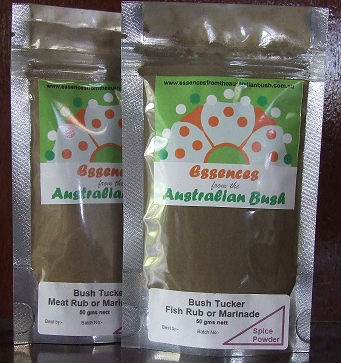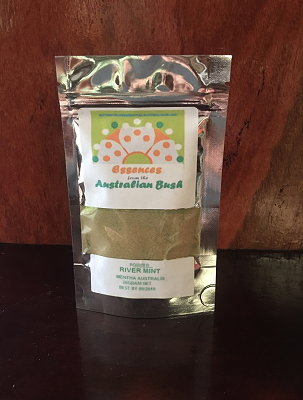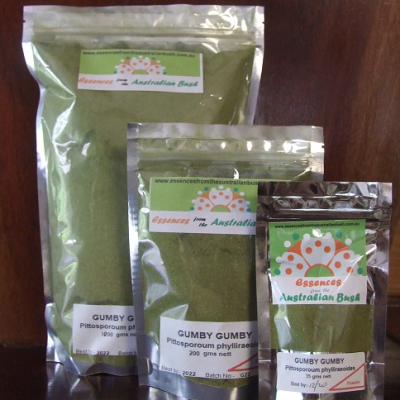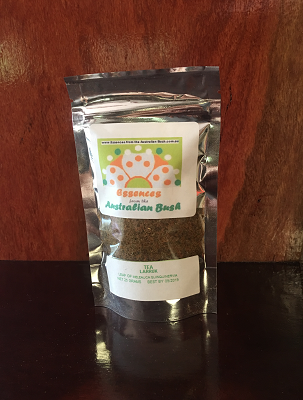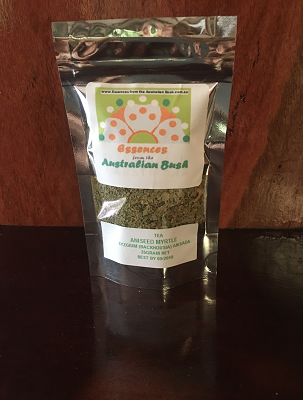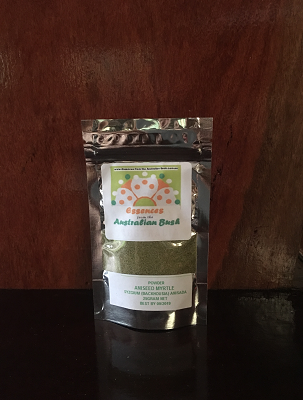MATERIAL SAFETY DATA SHEET
MSDS: Tea Tree Essential Oil
SECTION: 1.1 PRODUCT IDENTIFICATION
Product Name: Tea Tree Essential Oil
Botanical Name: Melaleuca alternifolia
Recommended Use: Raw material
INCI Name: Melaleuca alternifolia (tea tree) leaf oil
CAS #: 85085-48-9
Country of Origin: Australia
SECTION: 1.2 COMPANY IDENTIFICATION
Company: Essences from the Australian Bush
Address: P.O. 3066, Pallas Street, Maryborough. QLD. Australia
Telephone No: 0408780709
24 HOUR EMERGENCY TELEPHONE NUMBER: 000
SECTION: 2. COMPOSITION / INFORMATION INGREDIENTS
CAS No.: EINECS No.: Range
85085-18-9 285-377-1 Melaleuca alternifolia, ext. 100%
SECTION: 3. HAZARDS IDENTIFICATION
According to the criteria of NOHSC, this material is classified as; Hazardous Substance, Dangerous Goods
Risk Phrases:
Flammable. Harmful if swallowed. Irritating to skin. May cause Sensitisation by skin contact. Toxic to Aquatic
Organisms. May cause lung damage if swallowed.
Safety Phrases:
Avoid contact with skin. In case of contact with eyes, rinse immediately with plenty of water and contact a doctor
or Poisons Information Centre. After contact with skin, wash immediately with plenty of soap and water. Wear suitable gloves. Wear eye/face protection. Avoid release to the environment. Refer to special instructions/safety data sheets. If swallowed, do not induce vomiting: seek medical advice immediately and show this container or label.
Poisons Schedule: S6
SECTION: 4. FIRST AID MEASURES
Eye Contact: Contact with eyes can produce burning sensation. Irrigate with water immediately, continue flushing eyes with water for 15 minutes. Seek medical attention if irritation persists.
Inhalation: Remove to fresh air. Give oxygen if breathing is laboured and seek medical advice. Avoid casual breathing. Signs of over exposure are dizziness and nausea.
Ingestion:
Rinse mouth; dilute with milk or water and consult a physician immediately. Do not induce vomiting. Never-give anything by mouth if victim is unconscious, is rapidly-losing or is
Convulsing.
Skin Contact: Skin contact can produce irritation, or itching of the skin. Remove contaminated clothing
Wash with soap and plenty of water. Seek medical attention if irritation persists. MATERIAL SAFETY DATA SHEET
MSDS: Tea Tree Essential Oil (Australia)
SECTION: 5. FIRE FIGHTING MEASURES
Flash Point: Flash Point: 47 °C (closed cup)
Extinguishing media: Carbon Dioxide, dry chemical or foam. Closed containers may build up pressure at elevated temperature
Special Procedures:
Determine the need to evacuate or isolate the area according to your local emergency plan.
Unusual Firefighting Hazards: None identified.
Protective Equipment: Self-contained breathing apparatus and protective clothing should be worn when fighting fires involving essential oils or chemicals.
Combustion Product: Carbon Monoxide, Carbon Dioxide
SECTION: 6. ACCIDENTAL RELEASE MEASURES
Personal Precautions: Use of self-contained breathing apparatus is recommended for any major chemical spill. Refer also to section 8.
Safety Precautions: Eliminate all ignition sources. Ventilate area. Determine the need to
Evacuate or isolate the area according to your local emergency plan.
Environmental Precautions: Keep away from drains, surface and ground water. Report spills to appropriate Authorities if required.
Methods for Cleaning Up:
Contain and collect with inert absorbent material and place in suitable container for disposal. Comply with all federal, state, and local regulation.
Wipe small spills with cloth. Clean with hot water and detergent.
SECTION: 7. HANDLING AND STORAGE
Handling:
Avoid inhalation and contact with skin and eyes. Good personal hygiene practices should be used. Wash after any contact, before breaks and meals, and at the end of the work period. Contaminated clothing and shoes should be cleaned before re-use.
Storage:
Containers should be kept closed in order to minimize contamination.
Store in a cool, dry, well ventilated place protected from light.
Keep away from extreme heat and from freezing conditions and away from all sources of ignition
Make sure the material does not come into contact with substances listed as: “Materials to Avoid”.
SECTION: 8. EXPOSURE CONTROLS AND PERSONAL PROTECTION
Eyes Protection: The use of safety glasses is recommended. If a material is to be handled in a manner where splashing may occur, the use of splash goggles or face shield is recommended
Respiratory Protection:
In well- ventilated areas, respiratory protection is not normally required. In confined, poorly ventilated areas the use of “NIOSH” approved respiratory protection normally required (use only if trained in proper use and with acceptable oxygen level).
Protective Gloves: Using chemical resistant gloves is recommended.
Protective Clothing: Using chemical resistant clothing is recommended.
Protective Equipment: An eyewash fountain and / or safety shower should be available in the work area. Acceptable industrial hygiene practices should be maintained. MATERIAL SAFETY DATA SHEET
MSDS: Tea Tree Essential Oil (Australia)
Note: These precautions are for room temperature handling. Use at elevated temperature or aerosol / spray applications may require additional precautions
SECTION: 9. PHYSICAL AND CHEMICAL PROPERTIES
Appearance: Colourless to pale yellow clear liquid.
Odour: Characteristic warm, spicy odour.
Solubility: Soluble in alcohol and oils. Insoluble in water.
Specific Gravity: 0.880 – 0.906 @ 20°C
Optical Rotation: +5.0 – +15 @ 20°C
Refractive Index: 1.4750 – 1.4820 @ 20°C
Extraction Method: Steam distillation of the fresh leaves.
Contents: Terpinen-4-ol, cineol, terpinene, Pinene, Sabine, Cymene, limonene,
Terpinolene, Terpineol, Aromadendrene, Cadinene, Globulol, Viridiflorol.
SECTION: 10. STABILITY AND REACTIVITY
Stability: Chemically stable.
This material presents no significant reactivity hazard.
Conditions to Avoid: Avoid sparks, flame and excessive heat.
Materials to Avoid: Strong oxidizing agents.
Flammability: Flammable liquid.
Hazardous Polymerization: Will not occur.
Hazardous Combustion or None known.
Decomposition Products: When heated to decomposition produces acid fumes and carbon monoxide smoke.
SECTION: 11. TOXICOLOGICAL INFORMATION
Inhalation:
Inhalation of high concentrations of vapour may result in irritation of eyes, nose and throat, headache, nausea, and dizziness.
Skin Contact:
Repeated or prolonged contact of full strength product can cause redness, irritation and scaling of skin. Adverse skin effects should be prevented by normal care and personal hygiene
Eye Contact: May irritate eyes.
Ingestion:
Low order toxicity causing irritation of the mouth, stomach and intestines which results in nausea and vomiting.
Medical Conditions Aggravated by Exposure: May aggravate dermatitis, psoriasis and other skin conditions.
Chronic Toxicity: May cause allergic reactions on skin
Carcinogenicity Data: None of the components of this material are listed as a carcinogen.
Reproductive Toxicity: No adverse effects on reproduction are known.
Acute Toxicity Values: No data is currently available. MATERIAL SAFETY DATA SHEET
MSDS: Tea Tree Essential Oil (Australia)
SECTION: 12. ECOLOGICAL INFORMATION
Toxic to aquatic organism may cause long-term adverse effects in the aquatic environment.
Avoid any pollution of ground, surface or underground water.
SECTION: 13. DISPOSAL CONSIDERATION
Incineration or sanitary landfill in accordance with local, provincial and federal regulations. Check with disposal expert to insure compliance
SECTION: 14. TRANSPORT INFORMATION
UN No. 2319: Terpene hydrocarbons, NOS
Packaging Group: III Class: 3 - Flammable Liquid Hazchem Code: 3Y
Sea Freight:: Reference P 3383 of IMDG Code.
SECTION: 15. REGULATORY INFORMATION
WHMIS (Canada): D2B, B3
EU Labelling: R10 Flammable.
Xn R22 Harmful if swallowed.
Xi R38 Irritating to skin
S36/37/38 Wear suitable protective clothing, gloves and eye/face protection
DISCLAIMER: This information relates only to the specific material designated and may not be valid for such material used in combination with any other materials or in any process. Such information is, to the best of the company’s knowledge and belief, accurate and reliable as of the date indicated. However, no warranty guarantee or representation is made to its accuracy, reliability or completeness. It is the user’s responsibility to satisfy himself as to the suitability of such information for his own particular use.

